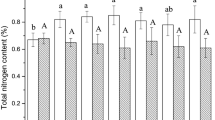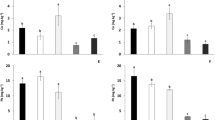Abstract
A greenhouse experiment was conducted to evaluate the growth and heavy-metal accumulation of Brassica chinensis and Agropyron elongatum in 10 and 25% ash–sludge co-compost (ASC)—amended loamy acidic soil (pH 4.51) at two different application rates: 20% and 40% (v/v). Soil pH increased, whereas electrical conductivity decreased with the amendment of ASC to soil. Bioavailable Cu, Zn, and Mn contents of ASC-amended soil decreased, whereas Ni, Pb, and B contents increased. Concentrations of bioavailable Cu, Zn, and Mn in sludge compost (SC)–amended soils were 5.57, 20.8, and 8.19 mg kg−1, respectively. These concentrations were significantly lower than those in soil receiving an application rate of 20 or 25% ASC as 2.64, 8.48, and 5.26 mg kg−1, respectively. Heavy metals and B contents of the composting mass significantly increased with an increase in ASC application rate from 20 to 40% (6.2 to 16.6 mg kg−1 for 10% ASC- and 9.4 to 18.6 mg kg−1 for 25% ASC-amended soil. However, when the ash content in co-compost increased from 10 to 25% during composting, bioavailable heavy-metal contents decreased. However, B contents increased with an increase in ash content. Addition of co-composts increased the dry-weight yield of the plants, and this increase was more obvious as the ash amendment rate in the co-composts and the ASC application rate increased. In case of B. chinensis, the biomass of 2.84 g/plant for 40% application of 25% ASC was significantly higher than SC (0.352 g/plant), which was 40% application of 10% ASC (0.434 g/plant) treatments. However, in A. elongatum, the differences between biomass of plants grown with 10% (1.34–1.94 g/ plant) and 25% ASC (2.12–2.21 g/plant) were not significantly different. Furthermore, there were fewer plant-available heavy metals in 25% ASC, which decreased the uptake of heavy metals by plants. ASC was favorable in increasing the growth of B. chinensis and A. elongatum. The optimal ash amendment to the sludge composting and ASC application rates were at 25 and 20%, respectively.
Similar content being viewed by others
References
Adriano DC (1981) Co-recycling of sewage sludge and fly ash: cadmium accumulation by crop. Environ Technol Lett 3:145–150
Adriano DC, Page AL, Elseewi AA, Chang AC, Straughan I (1980) Utilization of coal fly ash and other coal residues in terrestrial ecosystems: a review. J Environ Qual 9:333–334
Bingham FT (1982) Boron. In: Page AL, Miller RH, Keeney DR (eds) Methods of soil analysis. Part 2. Chemical and microbiological properties. 2nd ed. Agronomy Monograph No. 9. ASA and SSMA, Madison, WI, pp 431–448
Carlson CL, Adriano DC (1993) Environmental impacts of coal combustion residues. J Environ Qual 22:227–247
Chiang KY, Yoi SD, Lin HN, Wang KS (2001) Stabilization of heavy metals in sewage sludge composting process. Water Sci Technol 44:95–100
Dowdy RH, Sloan JJ, Dolan MS (1999) Bioavailability of cadmium and zinc 18 years post biosolids application. In: Wenzel WW, Peerzynski GM (eds) Proceedings of the 5th international conference on biogeochemicals trace elements, vol 1. Vienna, Austria, July 11–15, pp 274–275
Ebbs SD, Kochian LV (1997) Toxicity of zinc and copper to Brassica species: implications for phytoremediation. J Environ Qual 26:776–781
Elseewi AA, Straughan IR, Page AL (1980) Sequential cropping of fly ash amended soils: effects on soil chemical properties and yield and elemental composition of plants. Sci Total Environ 15:247–259
Fang M, Wong JWC (1999) Effects of lime amendment on availability of heavy metals and maturation in sewage sludge composting. Environ Pollut 106:83–89
Fang M, Wong JWC, Li GX, Wong MH (1998) Changes in biological parameters during co-composting of sewage sludge and coal ash residues. Bioresour Technol 64:55–61
Fang M, Wong JWC, Ma KK, Wong MH (1999) Co-composting of sewage sludge and coal fly ash: nutrient transformations. Bioresour Technol 67:19–24
Ghuaman GS, Menon MP, Chandra K, James J, Adriano DC, Sajwan KS (1992) Uptake of multielementals by corn from fly ash-compost amended soil. Water Air Soil Pollut 72:285–295
Keeney DR, Nelson DW (1982) Nitrogen—inorganic forms. In: Page AL, Miller RH, Keeney DR (eds) Methods of soil analysis. Part 2. Chemical and microbiological properties, 2nd ed. Agronomy Monograph No. 9. ASA and SSMA, Madison, WI, pp 643–698
Krebs R, Gupta SK, Furrer G, Schulin R (1998) Solubility and plant uptake of metals with and without liming of sludge-amended soils. J Environ Qual 27:18–23
Kukier U, Summer ME, Miller WP (1994) Boron release from fly ash and its uptake by corn. J Environ Qual 23:596–603
Lau SSS, Fang M, Wong JWC (2001) Effects of composting process and fly ash amendment on phytotoxicity of sewage sludge. Arch Environ Contam Toxicol 40:184–191
Lee BB, Lee YB, Lee CH, Hong CO, Kim PJ, Yu C (2008) Characteristics of boron accumulation by fly ash application in paddy soil. Bioresour Technol 99:5928–5932
Logan TJ, Harrison BJ (1995) Physical characteristics of alkaline stabilized sewage sludge (N-Viro Soil) and their effects on soil physical properties. J Environ Qual 24:153–164
Lowther JR (1989) Use of a single sulphuric acid-hydrogen peroxide digest for the analysis of Pinus radiata needles. Commun Soil Sci Plant Anal 11:175–188
Matsi T, Keramidas VZ (1999) Fly ash application on two acid soils and its effect on soil salinity, pH, B, P and on ryegrass growth and composition. Environ Pollut 104:107–112
Menon MP, Sajwan KS, Ghuman GS, James J, Chandra K (1993) Fly ash-amended compost as a manure for agricultural crops. J Environ Sci Health A 28:2167–2182
Nelson DW, Sommers LE (1982) Total carbon, organic carbon and organic matter. In: Page AL, Miller RH, Keeney DR (eds) Methods of soil analysis. Part 2. Chemical and microbiological properties, 2nd edn. Agronomy Monograph No. 9. ASA and SSMA, Madison, WI, pp 539–579
O’Conner GA, Granato TC, Dowdy RH (2001) Bioavailability of biosolids molybdenum to corn. J Environ Qual 30:140–146
Oliver DP, Schultz JE, Tiller KG, Merry RH (1993) The effect of crop rotations and tillage practices on cadmium concentrations in wheat grain. Aust J Agric Res 44:1221–1234
Olsen SR, Sommers LE (1982) Phosphorus. In: Page AL, Miller RH, Keeney DR (eds) Methods of soil analysis. Part 2. Chemical and microbiological properties, 2nd ed. Agronomy Monograph No. 9. ASA and SSMA, Madison, WI, pp 403–430
Ponnamperuma FN, Cayton MT, Lantin RS (1981) Dilute hydrochloric acid as an extractant for available zinc, copper and boron in rice soils. Plant soil 61:297–310
Reynolds K, Kruger R, Rethman N, Truter W (2002) The production of an artificial soil from sewage sludge and fly-ash and the subsequent evaluation of growth enhancement, heavy metal translocation and leaching potential. Water SA Special Edition. WISA Proceedings 2002, pp 73–77
Richards LA (1954) Diagnosis and improvement of saline and alkaline soils. United States Salinity Lab Agricultural Handbook. No. 60
Sajwan KS, Ornes WH, Youngblood T (1995) The effect of fly ash/sewage sludge mixtures and application rates on biomass production. J Environ Sci Health A Sci Eng Toxic Hazard Subst Control 30:1327–1337
Sims JT, Vasilas BL, Ghodrati M (1995) Evaluation of fly ash as a soil amendment for the Atlantic Coastal Plain: II. Soil chemical properties and crop growth. Water Air Soil Pollut 81:363–372
Soltanpour PN (1991) Determination of nutrients availability and elemental toxicity by AB-DTPA soil test and ICPs. Adv Soil Sci 16:165–189
Smith RS (1996) Agricultural recycling of sewage sludge and the environment. CAB International, Wallington, UK
Su DC, Wong JWC (2002) The growth of corn seedlings in alkaline coal fly ash stabilized sewage sludge. Water Air Soil Pollut 133:1–13
Su DC, Wong JWC (2004) Chemical speciation and phytoavailability of Zn, Cu, Ni and Cd in soil amended with fly ash-stabilized sewage sludge. Environ Int 29:895–900
Truter WF, Rethman NFG, Reynolds KA, Kruger RA (2001) The use of a soil ameliorant based on fly ash and sewage sludge. In: Proceedings of the international ash utilization symposium, Lexington, KY, October 22–24, 2001. Center for Applied Energy Research, University of Kentucky, Lexington, KY
Tsadilas CD, Samaras V, Kazai P, Sgouras J (2002) Fly ash and sewage application on an acid soil and their influence on some soil properties and wheat biomass production. In: Proceedings of the 12th international soil conservation organization conference, Beijing, China, May 26–31, pp 118–123
Wong MH (1985) Phytotoxicity of refuse compost during the process of maturation. Environ Pollut 37:159–174
Wong JWC (1995) The production of artificial soil mix from coal fly ash and sewage sludge. Environ Technol 16:741–751
Wong JWC, Su DC (1997) The growth of Agropyron elongatum in an artificial soil mix from coal fly ash and sewage sludge. Bioresour Technol 59:57–62
Wong JWC, Wong MH (1990a) Effects of fly ash on yields and elemental composition of two vegetables: Brassica parachinensis and B. chinensis. Agric Ecosyst Environ 26:23–35
Wong MH, Wong JWC (1990b) Germination and seedling growth of vegetable crops in fly ash-amended soil. Agric Ecosyst Environ 30:251–264
Wong JWC, Jiang RF, Su DC (1996a) Boron availability in ash-sludge mixture and its uptake by corn seedlings (Zea mays L.). Soil Sci 161:182–187
Wong JWC, Li GX, Wong MH (1996b) The growth of Brassica chinensis in heavy metal contaminated sewage sludge compost from Hong Kong. Bioresour Technol 58:309–313
Wong JWC, Fang M, Li GX, Wong MH (1997) Feasibility of co-composting coal ash residues with sewage sludge. Environ Technol 18:563–568
Wong JWC, Jiang RF, Su DC (1998) The accumulation of boron in Agropyron elongatum grown in coal fly ash and sewage sludge mixture. Water Air Soil Pollut 106:137–147
Wong JWC, Lai KM, Su DS, Fang M (2001a) Toxicity evaluation of sewage sludges in Hong Kong. Environ Int 27:373–380
Wong JCW, Lai KM, Su DS, Fang M (2001b) Availability of heavy metals for Brassica chinensis grown in an acidic loamy soil amended with a domestic and industrial sewage sludge. Water Air Soil Pollut 128:339–353
Author information
Authors and Affiliations
Corresponding author
Rights and permissions
About this article
Cite this article
Wong, J.W.C., Selvam, A. Growth and Elemental Accumulation of Plants Grown in Acidic Soil Amended With Coal Fly Ash–Sewage Sludge Co-compost. Arch Environ Contam Toxicol 57, 515–523 (2009). https://doi.org/10.1007/s00244-009-9308-9
Received:
Accepted:
Published:
Issue Date:
DOI: https://doi.org/10.1007/s00244-009-9308-9




